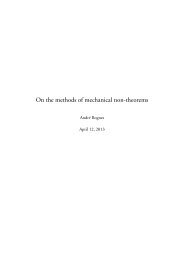Real-Time GPU Silhouette Refinement using adaptively blended ...
Real-Time GPU Silhouette Refinement using adaptively blended ...
Real-Time GPU Silhouette Refinement using adaptively blended ...
Create successful ePaper yourself
Turn your PDF publications into a flip-book with our unique Google optimized e-Paper software.
implies that our algorithm must recompute the Bézier coefficients<br />
accordingly. Our implementation is described<br />
sequentially, although some steps do not require the previous<br />
step to finish. A flowchart of the implementation<br />
can be found in Figure 7.<br />
6.1 <strong>Silhouette</strong>ness calculation<br />
<strong>Silhouette</strong>ness is well suited for computation on the <strong>GPU</strong><br />
since it is the same transform applied to every edge and<br />
since there are no data dependencies. The only changing<br />
parameter between frames is the viewpoint.<br />
If the mesh is static we can pre-compute the edgemidpoints<br />
and neighboring triangle normals for every<br />
edge as a preprocessing step and store these values in a<br />
texture on the <strong>GPU</strong>. For a dynamic mesh we store the indices<br />
of the vertices of the two adjacent triangles instead<br />
and calculate the midpoint as part of the silhouetteness<br />
computation.<br />
The silhouetteness of the edges is calculated by first<br />
sending the current viewpoint to the <strong>GPU</strong> as a shader uniform,<br />
and then by issuing the rendering of a textured rectangle<br />
into an off-screen buffer with the same size as our<br />
edge-midpoint texture.<br />
We could alternatively store the edges and normals of<br />
several meshes in one texture and calculate the silhouetteness<br />
of all in one pass. If the models have different model<br />
space bases, such as in a scene graph, we reserve a texel<br />
in a viewpoint-texture for each model. In the preprocessing<br />
step, we additionally create a texture associating the<br />
edges with the model’s viewpoint texel. During rendering<br />
we traverse the scene graph, find the viewpoint in the<br />
model space of the model and store this in the viewpoint<br />
texture. We then upload this texture instead of setting the<br />
viewpoint explicitly.<br />
6.2 Histogram pyramid construction and<br />
extraction<br />
The next step is to determine which triangles should be<br />
refined, based on the silhouetteness of the edges. The<br />
straightforward approach is to read back the silhouetteness<br />
texture to host memory and run sequentially through<br />
the triangles to determine the refinement level for each of<br />
them. This direct approach rapidly congests the graphics<br />
bus and thus reduces performance. To minimize transfers<br />
over the bus we use a technique called histogram pyramid<br />
extraction [23] to find and compact only the data that<br />
we need to extract for triangle refinement. As an added<br />
benefit the process is performed in parallel on the <strong>GPU</strong>.<br />
The first step in the histogram pyramid extraction is to<br />
select the elements that we will extract. We first create a<br />
binary base texture with one texel per triangle in the mesh.<br />
A texel is set to 1 if the corresponding triangle is selected<br />
for extraction, i.e. has at least one edge with non-zero<br />
silhouetteness, and 0 otherwise. We create a similar base<br />
texture for the edges, setting a texel to 1 if the corresponding<br />
edge has at least one adjacent triangle that is selected<br />
and 0 otherwise.<br />
For each of these textures we build a histopyramid,<br />
which is a stack of textures similar to a mipmap pyramid.<br />
The texture at one level is a quarter of the size of the<br />
previous level. Instead of storing the average of the four<br />
corresponding texels in the layer below like for a mipmap,<br />
we store the sum of these texels. Thus each texel in the<br />
histopyramid contains the number of selected elements in<br />
the sub-pyramid below and the single top element contains<br />
the total number of elements selected for extraction.<br />
Moreover, the histopyramid induces an ordering of the selected<br />
elements that can be obtained by traversal of the<br />
pyramid. If the base texture is of size 2 n ×2 n , the histopyramid<br />
is built bottom up in n passes. Note that for a static<br />
mesh we only need a histopyramid for edge extraction and<br />
can thus skip the triangle histopyramid.<br />
The next step is to compact the selected elements. We<br />
create a 2D texture with at least m texels where m is the<br />
number of selected elements and each texel equals its index<br />
in a 1D ordering. A shader program is then used to<br />
find for each texel i the corresponding element in the base<br />
texture as follows. If i > m there is no corresponding selected<br />
element and the texel is discarded. Otherwise, the<br />
pyramid is traversed top-down <strong>using</strong> partial sums at the<br />
intermediate levels to determine the position of the i’th<br />
selected element in the base texture. Its position in the<br />
base texture is then recorded in a pixel buffer object.<br />
The result of the histopyramid extraction is a compact<br />
representation of the texture positions of the elements for<br />
which we need to extract data. The final step is to load associated<br />
data into pixel buffer objects and read them back<br />
to host memory over the graphics bus. For static meshes<br />
we output for each selected edge its index and silhouetteness.<br />
We can thus fit the data of two edges in the RGBA<br />
Draft<br />
Draft<br />
7
















